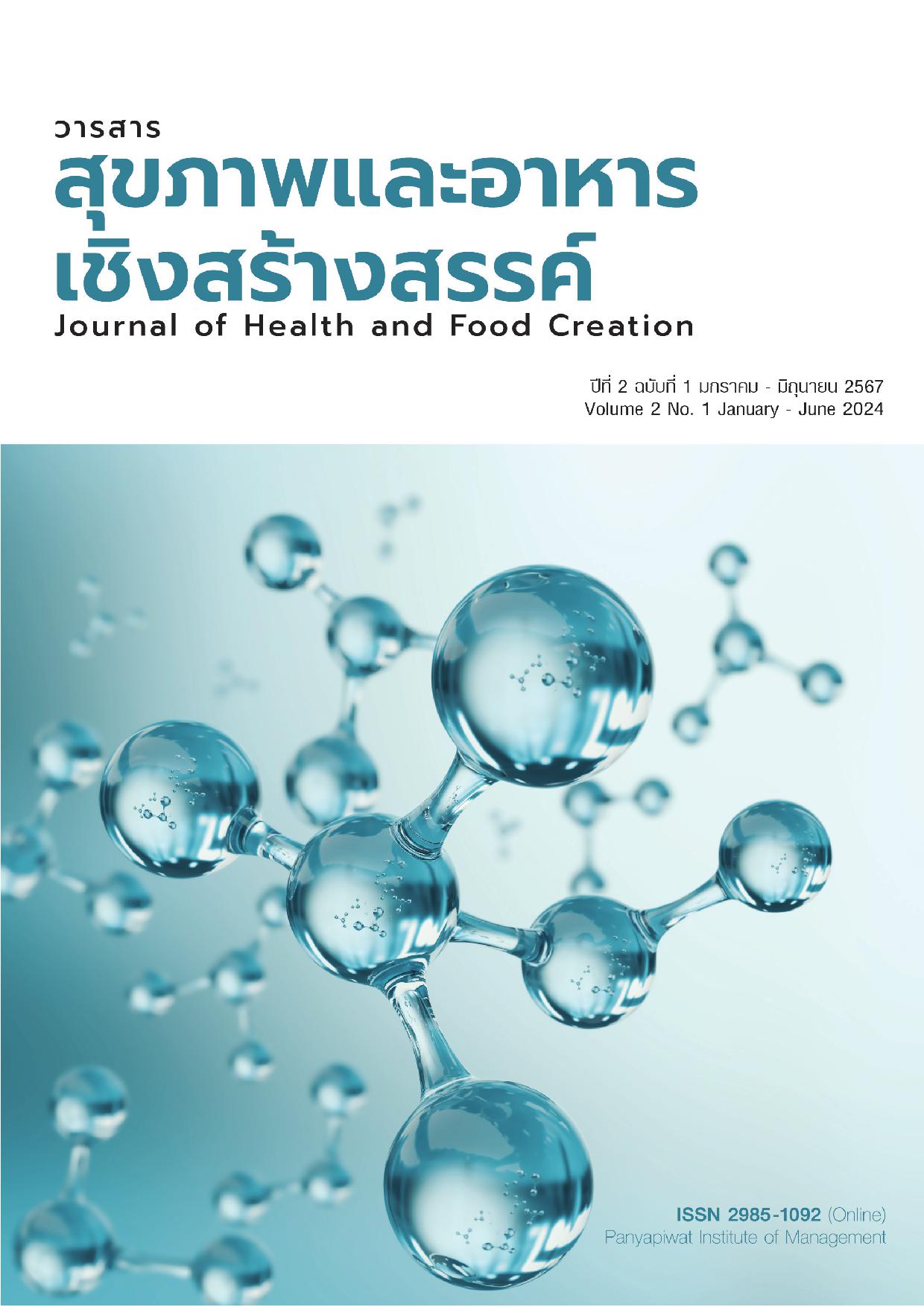แนวทางการบริหารจัดการธุรกิจร้านอาหารภายใต้แนวคิดเศรษฐกิจสร้างสรรค์เพื่อสร้างความได้เปรียบทางการแข่งขันอย่างยั่งยืน
คำสำคัญ:
เศรษฐกิจสร้างสรรค์, ธุรกิจร้านอาหาร, การจัดการ, ความได้เปรียบทางการแข่งขัน, ความยั่งยืนบทคัดย่อ
บทความวิชาการนี้มีวัตถุประสงค์เพื่อเสนอแนวคิดการบริหารจัดการธุรกิจร้านอาหารภายใต้แนวคิดเศรษฐกิจสร้างสรรค์เพื่อสร้างความได้เปรียบทางการแข่งขันอย่างยั่งยืน บทความนี้จะกล่าวถึงเนื้อหาที่สอดคล้องกันดังนี้ รูปแบบของธุรกิจร้านอาหารในยุคดิจิทัล แนวคิดเศรษฐกิจสร้างสรรค์ แนวทางการดำเนินธุรกิจร้านอาหารภายใต้แนวคิดเศรษกิจสร้างสรรค์เพื่อสร้างความได้เปรียบทางการแข่งขันอย่างยั่งยืน จำนวน 7 แนวทางได้แก่ 1) การจัดการที่เป็นมิตรต่อสิ่งแวดล้อม 2) การมุ่งเน้นความปลอดภัย 3) การสร้างสรรค์รายการอาหาร 4) การประยุกต์ใช้เทคโนโลยีสารสนเทศ 5) การให้บริการที่ยั่งยืนและมีคุณภาพ 6) การเสริมสร้างความคิดสร้างสรรค์ในทีมงานและ 7) การสื่อสารทางการตลาดและการประชาสัมพันธ์ การศึกษาในครั้งนี้จะเป็นประโยชน์ให้ผู้ประกอบการธุรกิจอาหารนำ ไปประยุกต์ใช้ในการบริหารธุรกิจร้านอาหารให้เหมาะสมกับสถานการณ์ปัจจุบันสามารถสร้างความได้เปรียบทางการแข่งขันในธุรกิจได้อย่างยั่งยืนต่อไป
เอกสารอ้างอิง
Azanaw, J., Gebrehiwot, M., & Dagne, H. (2019). Factors associated with food safety practices among food handlers: Facility-based cross-sectional study. BMC Research Notes,12, 1-6.
Chattrawanit, C., & Pasunon, P. (2020). The cluster analysis of consumer behavior on acceptance of innovation affecting the decision to buy new ready-to-eat food style: A case study of undergraduate students in Nonthaburi province. MUT Journal of Business Adminis-tration, 17(2), 41-65. [in Thai]
Chirdchuepong, T., & Jongadsayakul, W. (2023). The behavior in QR code payment system. Journal of Social Science Panyapat, 5(3), 271-286. [in Thai]
Design for Creative Economy Research Unit. (2020). History of creative economy. http://www.dce.arch.chula.ac.th/creative-economy/ [in Thai]
Dietrich, G. (2014). Spin sucks: Communication and reputation management in the digital age. Indianapolis.
Dubrin, A. J. (2002). Fundamental of organizational of behavior: An applied approach (2nd ed.). South Western/Thomson Learning.
Farsani, N. T., & Shafiei, Z. (2015). Tourism: A solution for economic growth in developing countries (Case study: Iran). Progress in Economics Research, 32, 91-115.
Fichman, R. G. (2004). Going beyond the dominant paradigm for information technology innovation research: Emerging concepts and methods. Journal of the AIS, 5(8), 314-355.
Hou, J. S., Lin, C. H., & Morais, D. B. (2005). Antecedents of attachment to a cultural tourism destination: The case of Hakka and non-Hakka Taiwanese visitors to Pei-Pu, Taiwan. Journal of Travel Research, 44(2), 221-233.
Iraldo, F., Testa, F., Lanzini, P., & Battaglia, M. (2017). Greening competitiveness for hotels and restaurants. Journal of Small Business and Enterprise Development, 24(3), 607-628.
Jutrakul, S. (2020). Creative product innovation using Thai wisdom for creative marketing in the digital age. Journal of Communication Arts Review, 24(1), 234-246. [in Thai]
Kang, J. W., & Namkung, Y. (2016). Restaurant information sharing on social networking sites: Do network externalities matter? Journal of Hospitality & Tourism Research,40(6), 739-763.
Kwok, L., Huang, Y. K., & Hu, L. (2016). Green attributes for restaurant: What really matters to consumers? International Journal of Hospitality Management, 55, 107-117.
Lagerkvist, C. J., Amuakwa-Mensah, F., & Mensah, J. T. (2018). How consumer confidence in food safety practices along the food supply chain determines food handling practices: Evidence from Ghana. Food Control, 93, 265-273.
Lapchareonsaap, T., Kungvantip, V., & Jarupathirun, S. (2017). Segmenting consumers and eating out behaviour. Kasem Bundit Journal, 18(2), 37-50. [in Thai]
Malkawi, A. F. (2017). The impact of the use of information technology in improving the quality of services: A field study of fast-food restaurants in Jordan. European Scientific Journal, 13(23), 359.
Nithisiriwaritkun, W., Phonphuak, S., Nithichaianan, N., Chara, P., Prasongsuk, S., & Srisaphonphusitti, T. (2023). Developing and increasing the value of silk product in Surin province according to the creative economy concept. Journal of Local Governmence and Innovation, 7(3), 1-14. [in Thai]
Office of the National Economic and Social Development Council. (2009). The creative economy (2nd ed.). Office of the National Economic and Social Development Board and Thailand Creative & Design Centre. [in Thai]
Paekoed, J. (2020). Factors relating to purchase intention of Thai tourist regarding choosing to buy street foods around Phra Pathomchedi, Nakhonpathom province [Master’s thesis]. University of Phayao. [in Thai]
Pantelidis, V. S. (2009). Reasons to use virtual reality in education and training courses and a model to determine when to use virtual reality. Themes in Science and Technology Education, 2, 59-70.
SMEONE Empowering Thai SMEs. (2020, July 2). Want to open a restaurant or cafe, how do you start? https://www.smeone.info/posts/view/73 [in Thai]
Sodsee, S. (2022). Service quality factors, food quality and price value on customer satisfaction and revisit intention of customers in Bangkok [Master’s thesis]. Silpakorn University. [in Thai]
Soryiaya, A., Piancharoenwong, A., Rittiboonchai, W., & Bootpo, W. (2022). Marketing strategy development: Impact and adaptation of restaurants in Nakhon Pathom province during COVID-19. The 14th NPRU National Academic Conference Nakhon Pathom Rajabhat University (pp. 1788-1802). Nakhon Pathom Rajabhat University. [in Thai]
Srihiran, J. (2017). Risk management in catering services for the hotel business: A case study of five-star hotels in Bangkok. Dusit Thani Journal, 11(Special), 214-228. [in Thai]
Sugandini, D., Effendi, M. I., & Darasta, B. Y. (2020). Intention to use: Study online shopping based on android applications. Process Engineering, 2, 49-58.
Tan, B. C., Lau, T. C., Yong, G. F., Khan, N., & Nguyen, T. P. L. (2019). A qualitative study of green practices adoption for restaurants in Malaysia. Social Responsibility Journal, 15(8), 1087-1099.
Trade Policy and Strategy Office. (2023, August 28). The state of the food and beverage industry in Thailand: Challenges and adaptations for the survival of food and beverage businesses. https://tpso.go.th/document/2309-0000000168 [in Thai]
Xu, Y., & Jeong, E. (2019). The effect of message framings and green practices on customers’ attitudes and behavior intentions toward green restaurants. International Journal of Contemporary Hospitality Management, 31(6), 2270-2296.
Yodkaew, P. (2023). The development of Jok Woven textile creative products and packaging of Lao Khrang ethnic group in Nakhon Pathom province for promote OTOP Nawatvithi tourism. Journal of Social Science and Cultural, 7(1), 14-30
ดาวน์โหลด
เผยแพร่แล้ว
รูปแบบการอ้างอิง
ฉบับ
ประเภทบทความ
สัญญาอนุญาต
ลิขสิทธิ์ (c) 2024 วารสารสุขภาพและอาหารเชิงสร้างสรรค์

อนุญาตภายใต้เงื่อนไข Creative Commons Attribution-NonCommercial-NoDerivatives 4.0 International License.
“ข้าพเจ้าและผู้เขียนร่วม (ถ้ามี) ขอรับรองว่า บทความที่เสนอมานี้ยังไม่เคยได้รับการตีพิมพ์และไม่ได้อยู่ระหว่างกระบวนการพิจารณาลงตีพิมพ์ในวารสารหรือแหล่งเผยแพร่อื่นใด ข้าพเจ้าและผู้เขียนร่วมยอมรับหลักเกณฑ์การพิจารณาต้นฉบับ ทั้งยินยอมให้กองบรรณาธิการมีสิทธิ์พิจารณาและตรวจแก้ต้นฉบับได้ตามที่เห็นสมควร พร้อมนี้ขอมอบลิขสิทธิ์บทความที่ได้รับการตีพิมพ์ให้แก่สถาบันการจัดการปัญญาภิวัฒน์หากมีการฟ้องร้องเรื่องการละเมิดลิขสิทธิ์เกี่ยวกับภาพ กราฟ ข้อความส่วนใดส่วนหนึ่งและ/หรือข้อคิดเห็นที่ปรากฏในบทความข้าพเจ้าและผู้เขียนร่วมยินยอมรับผิดชอบแต่เพียงฝ่ายเดียว”






